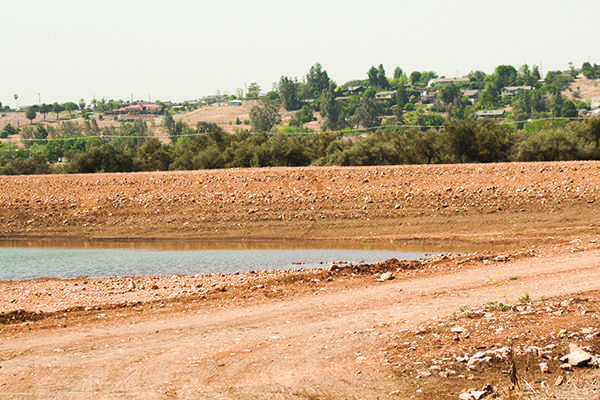
Photo by: Albertina Rodriguez Delgado
Houses sit on Snob Hill in Porterville, California as dry grass and low water levels are evident due to the drought. Many households have stopped watering their lawns due to restrictions.
Drought Brings Water Rationing and Alternative Landscaping
April 20, 2015
“It’s [water] not falling out of the sky, it’s not running down the rivers and it’s not coming out of the springs,” said Jeannine Koshear, Fresno City College Geography instructor.
The heaping warm weather and decrease in water from California has been taking a stroll since 2011 and is continuing to 2015.
Kearney Agricultural Research and Extension Center shows that Fresno had 1.39 inches of rain throughout January 2012 while it dropped to 0.18 inches during January 2015.
California has been suffering through the lack of water for four years while the weather has been increasing, which causes the dry environment.
The average temperature during March 2014 was 62.4 degrees, according to the National Weather Service Forecast Office. Koshear said that Fresno came across “record breaking temperatures” during the weekend of March 28, as it reached over 80 degrees.
California’s supply of water has slowly been evaporating, leaving residents curious about upcoming drought conditions during the summer.
“It’s going to be a long, hot and dry summer,” said Fresno City College Geology instructor, Craig Poole.
Poole suspects that there will be more water rationing and “a lot of people are not going to be use to that,” he said.
The City of Fresno has been on the second stage of the Water Storage Contingency Plan since November 2014 which enforces the community to water their lawns twice a week, during the summer and once a week during winter.
Both Koshear and Poole believes that the current drought condition calls for the possibility of reducing lush landscaping.
“We can pay more attention by conserving as much water as possible and perhaps getting rid of our lush landscaping,” said Poole.
Koshear said that turning lush landscaping into xeriscaping would be more ideal for the current situation.
A bigger obstacle that residents cannot control as much is the amount of snow that is produced on the highest points of the mountains.
The snowpacks that are created at the highest points of the mountains are slowly reducing the amount of water that is produced from the snowmelts.
Poole has taken multiple trips to the mountains and “there’s just hardly any snow up there, which is scary,” he said.
The snowmelt is a tool that gets California through the year as it keeps the creeks and rivers running overtime, says Poole.
Some fracture systems in the rocks have not been replenishing as much, which will cause streams to dry up during the summer and the early fall, he said.
Due to the low snowpacks, Governor Jerry Brown ordered a mandatory 25 percent decrease on water use throughout California.
The amount of water that will be saved is approximately 1.5 million acre-feet of water.
This 25 percent reduction will order residents to change to drought tolerant landscaping, replacing appliances with water and energy efficient models, and more.
Users of agricultural water will also have to report their water use to state regulators.
Eighty percent of water is currently going towards agriculture while about 20 percent of water is being used by residents, said Koshear.
According to People for the Ethical Treatment of Animals [PETA], over 2,400 gallons of water is used to produce one pound of meat.
Koshear said, “you have to grow the feed for the steer, then you have the animal itself and then its drinking demands.”
Some farmers in the San Joaquin Valley have stopped growing citrus “because farmers know that they do not have the water to keep them alive,” Koshear said, “farmers don’t have the option of depending on groundwater.”
However, according to California Drought, Governor Brown signed a $1 billion dollar drought relief plan on March 27, which will allow communities that have lost a grand amount of water to have access to water and food service.
$10 million in grants have also been provided by the California Department of Food Agriculture to help create more than 150 conservation projects for acres throughout the state.
“I think that it’s a good response on the private estate because this is a crisis for pretty much the entire state as far as water availability,” said Koshear.